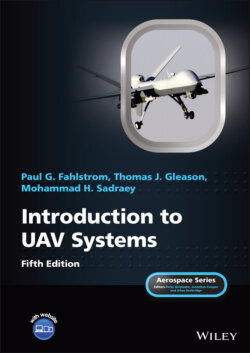Читать книгу Introduction to UAV Systems - Mohammad H. Sadraey - Страница 72
3.5 Pressure Distribution
ОглавлениеThe aerodynamic forces on an object in the airflow (e.g., wing) can be calculated from pressure distribution around the object. The lift of a wing/tail is produced due to the pressure difference between the lower and upper surfaces. An airfoil‐shaped body moved through the air will vary the static pressure on the top surface and on the bottom surface of the airfoil.
In a positive cambered airfoil (at a positive angle of attack), the upper surface static pressure in less than ambient pressure, while the lower surface static pressure is higher than ambient pressure. This is due to the higher airspeed at the upper surface and the lower speed at the lower surface of the airfoil (see Figure 3.8). As the airfoil angle of attack increases, the pressure difference between the upper and lower surfaces will be higher.
The wing three‐dimensional (3d) lift coefficient (CL) is directly a function of the airfoil two‐dimensional (2d) lift coefficient, cl. In turn, the variable cl is a function of variations of pressure coefficients on the upper and lower surfaces. For the case of a small angle of attack (less than 5 degrees), the 2d lift coefficient is calculated from
Figure 3.8 Pressure distribution for an airfoil section
(3.4)
where Cpl and Cpu are pressure coefficients at the lower and upper surfaces respectively, and c is the airfoil chord. Thus, the lift is produced due to the pressure difference between the lower and upper surfaces of the wing/tail. References such as [8, 10, and 11] provide techniques to determine the pressure distribution around any lifting surface such as the wing. The variations of lift coefficient versus angle of attack are often linear below the stall angle. The UAVs are usually flying at an angle of attack below the stall angle (about 15 degrees).
The Northrop Grumman X‐47B (Figure 3.9) an experimental unmanned combat air vehicle (UCAV) has provisions for various payloads such as EO/IR/SAR/GMTI. Its aerodynamic design allows for a maximum speed of Mach 0.9+ and a range of 3,900 km. This UCAV with a blended wing‐body tailless configuration, a maximum takeoff weight of 44,567 lb (mass of 20,215 kg), and a wing span of 62.1 ft (18.9 m) is equipped with a single turbofan engine.
Figure 3.9 Northrop Grumman X‐47B UCAV
Figure 3.10 Net pressure distribution over an airfoil
Figure 3.11 Spanwise pressure distribution around a 3d wing
Figure 3.12 Downwash
Consider the net pressure distribution about an airfoil, as shown in Figure 3.10. It is apparent that a wing would have positive pressure on its underside and negative (in a relative sense) pressure on the top. This is shown in Figure 3.11 as plus signs on the bottom and minus signs on the top as viewed from the front or leading edge of the wing.
Such a condition would allow air to spill over from the higher pressure on the bottom surface to the lower pressure on the top, causing it to swirl or form a vortex. The downward velocity or downwash onto the top of the wing created by the swirl would be greatest at the tips and reduced toward the wing center, as shown in Figure 3.12.
Aerodynamics textbooks (e.g., Reference [8]) are a good source to consult for information about mathematical techniques for calculating the pressure distribution over the wing and for determining the flow variables.
